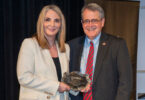By Courtney Smith
Presented by the Office of the Vice President for Instruction, the Creative Teaching Awards recognize UGA faculty for excellence in developing and implementing creative teaching strategies to improve student learning. Up to three awards are presented annually to encourage instructional excellence.
Richard Menke, an associate professor in English in the Franklin College of Arts and Sciences, has developed an innovative approach to analyzing a novel in collaboration with another faculty member and class from North Carolina State University.
Students from both classes worked on research teams together, using Skype and digital research tools to analyze data derived from Charles Dickens’ David Copperfield. The project, named “Data Copperfield,” was transformative for the students as they collaborated with peers from different universities and analyzed text in a data-derived format.
Montgomery Wolf, a senior lecturer of history in Franklin College, uses a variety of teaching methods, including service-learning, game-based learning and active-learning strategies such as “flipping the classroom.” In her classes, Wolf’s students examine primary sources and produce historical content to allow them to think and act like actual historians. She also encourages her students to use a range of learning technologies, like TopHat, WordPress and podcasting, to increase engagement opportunities.
Brock Woodson, an assistant professor, and Siddharth Savadatti, a lecturer, strive to impact learning and retention rates by incorporating active engagement strategies in their “Statics and Fluid Mechanics” courses in the College of Engineering.
They also employ flipped classroom practices by introducing students to topics via brief Web videos viewed outside of class, with homework assignments that include foundational problems based on concepts covered in the videos.
In class, students collaborate with instructors, teaching assistants and undergraduate students to work through more complex problems and concepts in both one-on-one and small group formats. Their teaching approach has moved introductory knowledge delivery outside of the classroom while employing hands-on problem-solving strategies in class.





